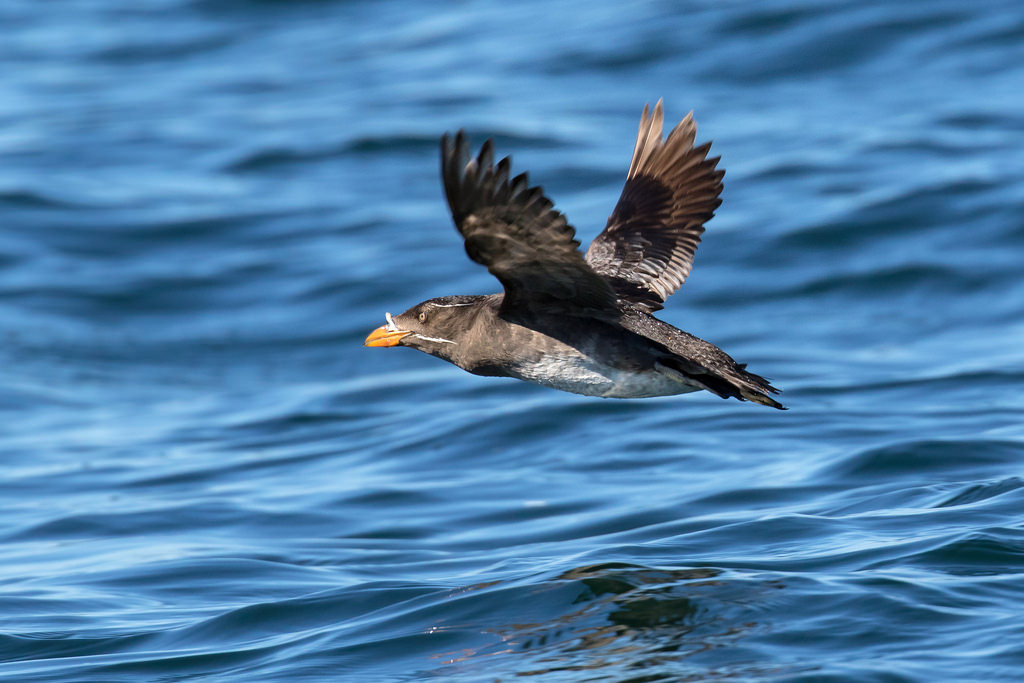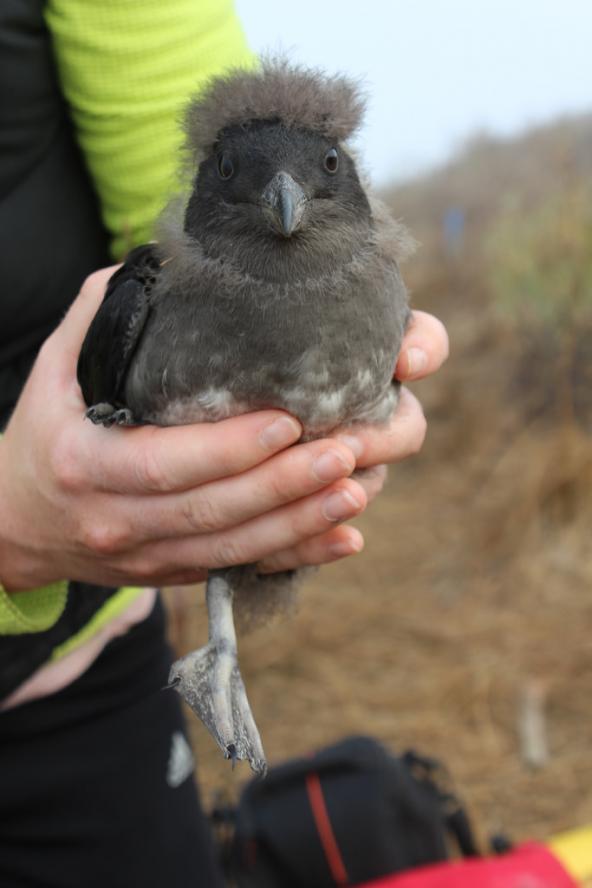
More than 70 percent of the seabird population of Puget Sound nests on a single island in the Strait of Juan de Fuca. That includes a massive colony of rhinoceros auklets that has drawn the interest of scientists and birders alike. Our writer Eric Wagner visited the island this summer and reports on a long-term study of the auklets that is revealing new information about the health of seabirds in the Salish Sea.

Protection Island sits just off the northern coast of the Olympic Peninsula, in the Strait of Juan de Fuca. Although less than a mile from the Washington mainland, it feels removed from it if not quite remote, with steep sandstone cliffs that front a small, artificial harbor. Top the cliffs, though, and rolling fields of grass spread out like a scene from an Andrew Wyeth painting. Of this landscape the British explorer George Vancouver wrote in 1792 that it reminded him of "an extensive lawn covered with luxuriant grass, and diversified with an abundance of flowers… almost as enchantingly beautiful as the most elegantly furnished pleasure grounds in Europe."
I cannot help but agree, if less floridly. "It's so pretty," I say to Scott Pearson, the biologist from the Washington Department of Fish and Wildlife who is driving up from the harbor.
"Yeah, but most of this is invasive cheat grass," Pearson says. "You'll be picking the seeds out of your socks for weeks."
Oh. Well then.

The SUV trundles along the winding road, past a water tower, past a few small conifers. ("…Promiscuously scattered…" Vancouver said of them.) The island is roughly three hundred and eighty acres in size, and broad and tabular. This made it attractive in a prospective-real-estate sort of way, Pearson tells me, so much so that there were once plans to subdivide the island into hundreds of lots for vacation homes. Developers went so far as to build roads, dig the harbor, delimit the lots, and even sell some of them before they found out that the island's water was undrinkable. And so the U.S. Fish and Wildlife Service acquired Protection Island and turned it into a refuge for seabirds in 1988, securing it to the care of its original and for now most numerous inhabitants: tens of thousands of rhinoceros auklets.
One of the world's largest colonies
The rhinoceros auklet is a seabird about the size of a rock dove. This makes it slightly smaller than its more famous relative, the tufted puffin. Where the puffin is so colorful and charismatic as to be dubbed "the clown of the sea," the auklet traffics in more muted grays — a sort of off-brand puffin, if you will. But not always. During the breeding season, adult auklets sport white wispy plumes above their eyes and on their cheeks. A small horn also sprouts from its bill, and this is how the species gets its common name.
What the auklet lacks in visual charm it makes up for in population, at least in the Salish Sea, where it is considerably more numerous than the puffin. The colony on Protection Island is the largest in the state of Washington and the seventh or eighth largest in the world. About thirty-six thousand or so pairs breed here according to the most recent estimates. Not that this is in any way obvious right now, during the day. One can drive all over the island, as Pearson is, and see nary an auklet. This is because auklets nest in deep and sometimes convoluted burrows that they visit only under cover of darkness. (Rhinoceros auklets are not the most agile fliers, and coming to land at night helps prevent them from falling prey to the island's several marauding bald eagles.)
There is one time, however, when rhinoceros auklets can be seen fairly easily on land, and that is when they die en masse. Such was the case beginning in May of 2016, when observers began to find dead auklets washed up on beaches and shorelines around the eastern edge of the Strait of Juan de Fuca. Throughout the summer months, volunteers with the Coastal Observation and Seabird Survey Team in the U.S. and the British Columbia Beached Bird Survey in Canada, as well as federal and state personnel, counted hundreds of carcasses, both juveniles and adults. Most showed signs of illness and emaciation. The unusual mortality event, as it was called, caught the attention of biologists throughout the region, who wondered whether it was a one-time occurrence, or a sign of things to come.

Tracking the birds
Pearson pulls into a small field house and everyone starts to offload research gear. Also along are Tom Good, Peter Hodum, and Sue Thomas, each biologists from, respectively, NOAA, the University of Puget Sound, and the U.S. Fish and Wildlife Service. All of them have been closely monitoring the Protection colony since 2005, visiting the island throughout the summer to track burrow occupancy and chick development via infrared cameras that they carefully coax into burrows via long cables. Joining them on this trip are Sarah Hudson and Alice Domalik, two biologists with Environment Canada. They have come to apply GPS transmitters to a few adult auklets, to see where they go to hunt for fish. As close as these auklets are to people, where they forage is still not well understood, and in the wake of the die-off, such information is important.
If you are not a bald eagle, catching a rhinoceros auklet so you can apply a tag to it is a challenge. The best way to do it is wait for the birds to come back to their burrows, which they start to do around 10 or 11 or so at night , or even later if the moon is bright. This is what has Hudson and Domalik out several hours later, shivering in a swale at 1 a.m. Earlier in the afternoon they set a few snares over auklet burrows known to be occupied this season. (Burrow occupancy rates are better than they were last year, when they were at a twelve-year low, but are still below the annual average. "I think we're still seeing the effects of the mortality event," Hodum says.)

Both auklet parents provision their single chick almost every night, so the chances of catching one (or six) are high. Every fifteen minutes Hudson or Domalik check the snares, withdrawing whatever trussed auklets they come upon. These they weigh, measure, and band. Then they tape tags to the auklets' backs. The tags are small. They weigh less than four grams. They will stay on the auklets for a few days before they fall off.
Once the birds are released, they flee into the darkness, or fling themselves into the air. In the days to come, the tracks from the tags will show how much auklets become transboundary birds when they forage. Of the five tagged birds, three stick close to the Washington coast, traveling west, one as far as Port Angeles, which is more than twenty miles away as the auklet flies. But two flew nearly thirty miles all the way across the strait and fish near Victoria.
"They may nest here in the States," Hudson says, "but these are our birds, too."
Diet studies
Just as important as knowing where the auklets go to fish is knowing what fish they are catching to feed to their chicks. One reason the auklet die-off of 2016 was both notable and worrisome is that auklets are known to be fairly flexible consumers. They would seem, then, to be relatively insulated from most environmental vagaries under most circumstances. But they can only eat what the sea gives them. Diet studies have shown that birds on Protection Island, which are more or less governed by the Salish Sea, eat predominantly sand lance, a slender forage fish, as well as some greenling and anchovy. Another colony off the outer Washington coast, on Destruction Island, is influenced more by the California Current. Auklets there eat more anchovy and whitebait smelt.

But there can be interannual variabilities, so to see what the auklets are making do with this year, after the night of tagging, Pearson and Good and Hudson and Domalik and I spread ourselves across one of the southern bluffs. The aim is to catch auklets when they come in to land, causing them to drop their bill-loads, which we will then analyze by species composition and caloric content. Hudson and Domalik also intend to take the stomachs from larger fish for further analysis; a 2014 study by Good, Pearson, Hodum and others found that the fish Protection Island auklets ate had two to four times the contaminant levels of Destruction Island fish.
Good, Thomas & Pearson, Scott & Hodum, Peter & Boyd, Daryle & F Anulacion, Bernadita & Ylitalo, Gina. (2014). Persistent organic pollutants in the diet of rhinoceros auklets (Cerorhinca monocerata) breeding in Puget Sound and the northern California Current. Marine Pollution Bulletin. 10.1016/j.marpolbul.2014.06.042.
The evening is cool and the moon is bright. There is almost no fog. We could all have a long wait in front of us before the auklets feel safe enough to return. "It's fun just sitting here on the slope, listening to the sounds," Hudson says from a few yards away. "You always hear better in the dark, you know?"
Related audio recordings on EoPS:
Listen to the Sounds of rhinoceros auklets and chick
Yes, you can, but sometimes what you hear more than the sea and the wind are your own thoughts, and in this instance mine are on the auklets and the die-off. It was just the latest in a spate of unusual mortality events that have stretched all along the eastern edge of the northern Pacific, dating back to 2005. They have touched everything from common murres to gulls to suites of seabirds in the Bering Sea. "These sorts of things used to be fairly rare, remarkable events," Pearson had said. But in recent years, they seem to be occurring about every six months. The question has become whether it is time to shed a couple of letters from the nomenclature, and just go ahead and call them usual mortality events.
But now the auklets are starting to return, shadows in the bright moonlight blurring low over our heads. Some land in the grassy tussocks some distance from me, but others sweep over and turn back out to the strait to make another pass. Suddenly a bald eagle lands not twenty feet in front of Hudson, and about forty feet from me. It looks at her and then turns towards me and cocks its head and tenses, and before I have even registered that it is looking at me, some primal receptor in my body-the part most akin to the rhinoceros auklet, you could argue-knows what is coming. I instinctively flatten myself on my back as the eagle leaps up and flies at me, feet lowered, talons outstretched. I cannot say for sure when it realizes its mistake, but much too close for my comfort; it passes maybe a foot over my head and lands ten feet upslope of me.

"It thought you were an auklet!" Hudson calls out, laughing.
Later I will laugh at this, but not yet. The eagle and I stare each other down before it decides to try its luck elsewhere and flies off. I settle back onto the hillside to watch the auklets, and I feel with them the sort of fellowship that can only be shared among us potential prey items.
This article was produced as part of an ongoing series focusing on research and findings presented at the 2018 Salish Sea Ecosystem Conference. Presentations are available on the conference website.

